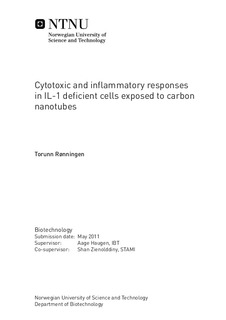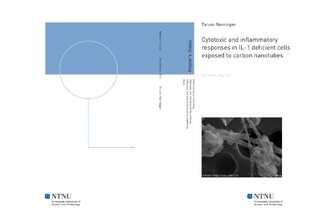| dc.description.abstract | Nanotechnology is an emerging industry manufacturing engineered nanomaterials used in industry, general consumer products and medicine. Nanomaterials are made of nanoparticles which have at least one dimension less than 100 nm. The toxicological properties of nanoparticles are under increasing concern because of their nano size and unique physico-chemical properties. Carbon nanotubes (CNT) are a group of nanomaterials that are under extensive toxicological investigations due to their fiber-like structure and structural similarity with asbestos. Inhalation of fiber-like compounds such as asbestos has been shown to lead to several adverse health effects including fibrosis and cancer. Similar to asbestos, CNTs, in particular multi-walled CNTs (MWCNT), have been shown to induce biological responses such as oxidative stress, inflammation, DNA damage and cell death. However the effects have been observed to differ between different CNTs. It is also hypothesized that genetic factors may modulate the cellular responses following exposure to CNTs, especially genes involved in inflammation. IL-1 is such a gene, encoding an important pro-inflammatory cytokine. To investigate the effect of Il1 on the cellular responses following exposure to CNTs, an Il1 model system including a wild-type Il1 cell line and an Il1a/b (-/-) knock-out cell line were used. Two MWCNTs, one produced in Norway (MWCNT-NO) and one produced in Japan (MWCNT-JP) were investigated for cytotoxicity (WST-8 assay), apoptotic cell death (Hoechst/PI) and alterations in gene expression (qRT-PCR). The effects were then compared with cells exposed to Crocidolite asbestos and hydrogen peroxide. The results showed a dose and time dependent increase in toxicity for both MWCNT-NO and MWCNT-JP. MWCNT-JP was shown to be the most toxic at low doses and also induced a higher level of gene expression. MWCNT-NO, however, showed similar patterns to Crocidolite asbestos both concerning toxicity and gene expression after 24 hours in the Il1a/b KO cell line. A common property of MWCNT-NO and MWCNT-JP was the ability to induce expression of the Ptgs2 (COX-2) gene, an effect which was not seen for Crocidolite or H2O2. Il1 seemed to influence the biological response following MWCNT exposure, with increased toxicity in the knock-out cell line following MWCNT-JP exposure, and differential gene expression of Tnfa and Il6 between cell lines following MWCNT-NO exposure. Neither of the MWCNTs induced apoptotic cell death in the cell lines used. The reasons for the differences between particles in toxicity and inflammatory potential may be due to the higher length of the MWCNT-JP or different production method used, but several other factors may also be involved including differences in contaminations, surface charge and aggregation /agglomeration state. In summary, our results show that MWCNTs from two different producers affect cellular responses differentially. The changes in toxicity and gene expression following exposure varied between the tested MWCNTs, as well as between cell lines with different genetic background. | nb_NO |

